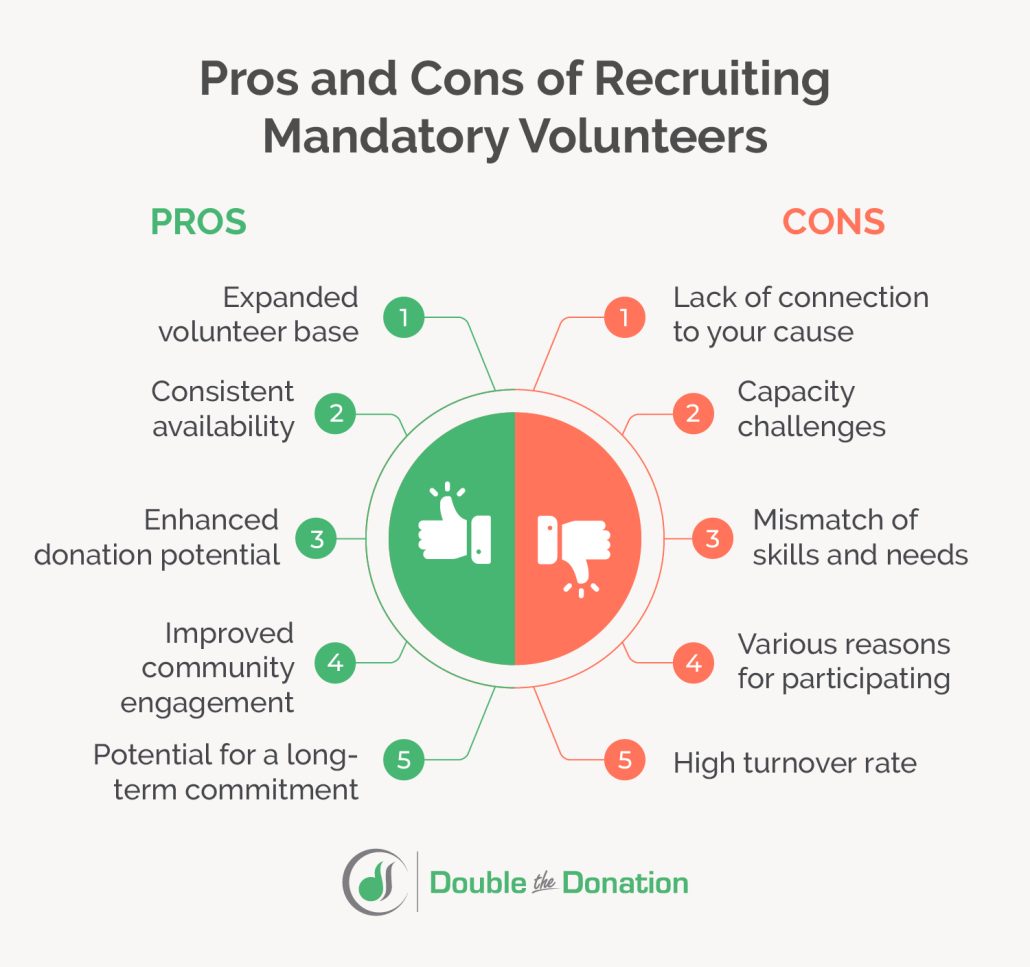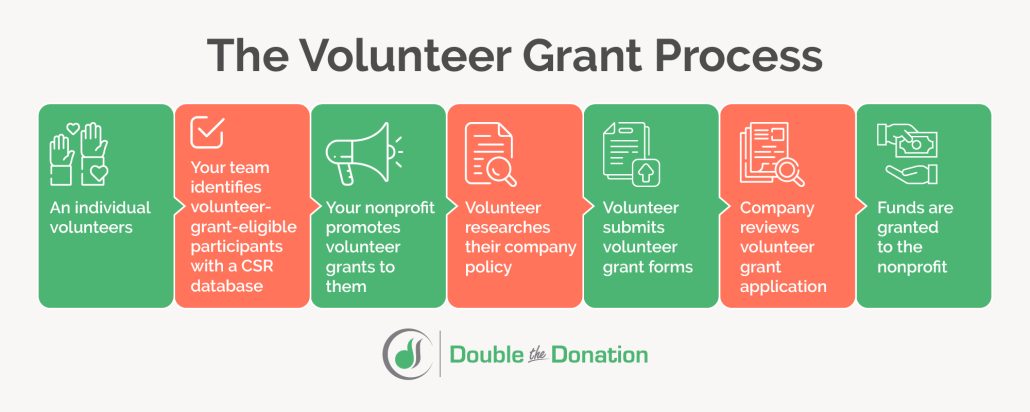Mandatory Volunteering: Unique Tips for Boosting Impact
Whether it’s a sorority, a food bank, or a socially responsible business, some organizations require their members to volunteer to build their skill sets and give back to their communities. Many nonprofits benefit from the temporary extra hands that mandatory volunteering provides, but there are many ways that you can convert these short-term volunteers into committed supporters, even after they’ve hit their hourly quota.
In this guide, we’ll go over the basics of mandatory volunteering programs and how your nonprofit can leverage them. Specifically, we’ll cover:
Let’s explore how your nonprofit can help your mandatory volunteering program reach its full potential.
Mandatory Volunteering FAQ
What is mandatory volunteering?
Mandatory volunteering is when an organization requires individuals to volunteer for a certain amount of time to receive benefits. Some examples of mandatory volunteering in practice include:
- Educational institutions require students to volunteer as a graduation requirement.
- Membership-based organizations require individuals to volunteer as a membership requirement.
- Social service organizations require individuals to volunteer to receive social services, such as food banks where beneficiaries contribute volunteer hours for meals.
- Judicial systems require individuals to volunteer in the form of community service as rehabilitation or restitution for minor offenses.
- Businesses require their employees to volunteer as a team-building exercise.
Chances are, your nonprofit has an organization in your area that mandates volunteering. Volunteers for these organizations can make great additions to your program—we’ll explore the benefits in-depth in a later section.
How does mandatory volunteering work?
Before you add mandatory volunteering outreach into your nonprofit’s recruitment strategy, you should understand how it works. While each organization is different, most mandatory volunteering programs function like this:
- The organization providing volunteers defines the objectives, rules, and structure of its mandatory volunteering program to complement its overall goals. Program guidelines might include the number of required volunteer hours or the type of volunteering the participant must complete.
- Often, the organization providing volunteers reaches out to a nonprofit and establishes a partnership. While a partnership isn’t required, it ensures that the nonprofit has a steady stream of volunteers while guaranteeing placements for those who are required to volunteer.
- The nonprofit provides custom onboarding and training for mandated volunteers based on their skill set, experience, and motivation for volunteering.
- Once the volunteers have hit their required hours, the nonprofit thanks them for their work and gives them an exit survey to see how it can improve their program.
As you can see, mandatory volunteer programs benefit from open communication and mutual understanding between nonprofits and the organizations that mandate volunteering.
What are the benefits and drawbacks of mandatory volunteering for nonprofits?
Recruiting mandated volunteers isn’t the best solution for every nonprofit. Before deciding to add it to your outreach strategy, take these pros and cons into account:
Pros:
- Expanded volunteer base. Mandated volunteers can improve your recruitment efforts and fill out your work schedule.
- Consistent availability. Mandated volunteers will make a greater effort to schedule and attend volunteer shifts so they can hit their hourly quota.
- Enhanced donation potential. Showing the importance of your mission through mandatory volunteering can inspire them to donate to your cause.
- Improved community engagement. Forming partnerships with volunteer providers can help you make connections with other organizations in your community.
- Potential for a long-term commitment. By being exposed to your nonprofit and mission, mandated volunteers might genuinely appreciate your staff, beneficiaries, and other aspects of your nonprofit and become long-term supporters even after they’ve hit their hours.
Cons:
- Lack of connection to your cause. Since mandated volunteers come to your nonprofit to fulfill a requirement, they might not have a strong affiliation with your cause, which can lead to burnout.
- Capacity challenges. Depending on the size of your mandated volunteer base, you might have to turn people away to avoid overwhelming your team or depleting your resources.
- Mismatch of skills and needs. Since your mandated volunteers might have specific hour requirements and limited choices in their placements, it’s possible that their skills won’t be a good match for your nonprofit’s needs.
- Various reasons for participating. Some of your volunteers might feel more or less enthusiastic about volunteering with you depending on their reasons for being there, which can impact their productivity and your overall performance.
- High turnover rate. Since many mandated volunteers are motivated by their hourly benchmark, they’re more likely to move on after they’re done working with your organization.
How can you gauge if recruiting mandated volunteers is right for your nonprofit?
Adding mandatory volunteering to your recruitment strategy can be a big decision. Use this decision tree to evaluate whether your nonprofit would benefit from recruiting mandated volunteers. Any “no” answers mean it might not be right for your nonprofit currently and any “yes” answers mean you should proceed to the next decision.
- Do you have a consistent need for volunteers?
- Can you accept the costs of training mandatory volunteers knowing that they may not stay engaged long-term?
- Can you provide meaningful and varied volunteer opportunities?
- Do you have the capacity to manage and train a large number of volunteers?
- Are there businesses, educational institutions, or social services organizations nearby to partner with?
- Can you ensure a positive experience for volunteers?
- Can your nonprofit accept the increased liability of working with mandated volunteers, including those fulfilling volunteer hours as part of court-ordered community service?
Please note that this is only a baseline decision tree. Each nonprofit is unique, so you should incorporate your own needs, goals, and preferences into account and adjust accordingly. Also, work with your legal team to review any potential legal issues or risks.
How to Turn Mandatory Volunteers into Lifelong [or Long-Term] Supporters
Accepting mandated volunteers into your program provides new opportunities to convert casual audience members into passionate donors and volunteers. You can convert them, boost fundraising, and secure your long-term success with these tips.
1. Spread awareness of volunteer grants and other CSR programs.
Many companies that mandate or highly encourage volunteering also offer other corporate social responsibility (CSR) programs, like volunteer grants and matching gifts. Mandated volunteers can amplify their positive impact by contributing volunteer grants to your nonprofit
Volunteer grants are a CSR program in which corporations promise monetary donations if an employee volunteers for a certain amount of hours with a nonprofit. Here’s how your nonprofit can promote and collect volunteer grants from mandated volunteers:
- An individual volunteers extensively at your nonprofit
- Your team identifies volunteer-grant-eligible participants with a CSR database like Double the Donation
- Your nonprofit reaches out to them, promoting volunteer grants and providing instructions for researching their policy
- The volunteer researches their company policy
- If the volunteer has met the policy requirements, they submit volunteer grant forms
- The company reviews the volunteer grant application
- If the application is approved, the company donates funds to the nonprofit
Besides volunteer grants, you can also promote other CSR programs to boost support for your mission. For instance, you can spread awareness of matching gifts, a CSR program in which employees can get their charitable contributions matched by their employer if they meet the program’s criteria. Research the types of CSR programs that your mandatory volunteers might respond well to and spread the word at an upcoming shift.
2. Focus on making lasting connections.
While their reasons for supporting your nonprofit may differ, mandated volunteers should be treated the same as other volunteers, which means you should strive to forge a personal relationship with them. Furthermore, mandated volunteers who feel welcomed and valued are more likely to continue working with your nonprofit. Here are some ways you can make mandated volunteers feel like part of the team:
- Get to know them personally. Simply learning all of your new volunteers’ names when they show up for their first shift demonstrates that you put effort into getting to know them as people. You can take it a step further by asking about your volunteers’ hobbies, experiences, and other personal information on their intake form.
- Offer social activities. Facilitate a welcoming community by allowing your volunteers to get to know each other outside of their shifts. For instance, you could organize a dinner at the end of a shift so mandated volunteers can make connections while bonding over great food.
- Invite them to fundraisers and other events. Introduce volunteers to new aspects of your organization by inviting them to fundraisers and other events. This can help them feel more connected to their work and gives you the chance to strike up a conversation with them.
- Provide progress updates. Show your volunteers the real impact of their work by updating them on your nonprofit’s progress. For example, you could let food bank volunteers know that a week’s worth of work yields an additional three hundred meals.
Genuinely showing that you care about your mandated volunteers as people is the most important component of motivating them to stick around after they’ve hit their quota. Take every opportunity to talk to them, compliment them on a job well done, and integrate them into your volunteer community.
3. Show your appreciation.
Your nonprofit relies on the help of your volunteers to execute your programs and give back to your beneficiaries at a high caliber. Showing your appreciation for their efforts isn’t just a nice thing to do—it also improves volunteer satisfaction and retention. Try these strategies for showing your gratitude to mandated volunteers:
- Create custom awards. Whether they’re performance-based or superlative, invite your volunteers to an awards ceremony where you recognize them for their accomplishments. Just make sure you get permission from each attendee to be recognized publicly.
- Take extra steps to improve your program. Go above and beyond to make your program stellar so mandated volunteers will want to stay. Ask them for feedback once they’ve completed a few shifts with your nonprofit and keep them updated on which items you plan to implement. For instance, you might start offering snacks for shifts that occur around a meal or adjusting your shift times so more people can attend.
- Offer volunteer development days. Skill development is a valuable perk that you can provide to show your thanks for their hard work and help them advance to a higher role within your program. For example, a food bank might offer training in floor management and more hours to high-performing individuals, giving them skills that they can add to their resumes.
- Send personalized thank-you messages. No matter how long they work with your nonprofit, you should thank each volunteer for their time. A handwritten note adds a unique personal touch that can feel more authentic than an email, so try to send those when you can. If you can only send emails, make sure each one is addressed to the recipient by name and mentions the specific project they worked on.
- Involve beneficiaries. Getting a thank-you message from a beneficiary can be an unexpected, yet welcome surprise for your mandated volunteers. Ask beneficiaries if they’d like to be part of a thank-you email or video. Your volunteers will feel more emotionally connected to your nonprofit when you match a face to the cause.
Thanking volunteers is a simple gesture that makes their work feel valued by your team and beneficiaries. Also, remember that not everything has to be a planned gesture—simply thanking volunteers verbally at the end of a shift can go a long way.
Wrapping Up + Additional Resources
Now that you know the details of mandatory volunteering, it’s time for your nonprofit to decide if adding it to your volunteer offerings is worthwhile. Once you’ve reviewed the pros and cons and conducted a needs assessment, evaluate your current community connections to gauge if you could easily forge any partnerships.
If you decide to integrate mandatory volunteers into your nonprofit’s ecosystem, personalize your stewardship approach and focus on providing a rewarding experience.
Looking for more information about how to incorporate corporate volunteerism into your nonprofit’s volunteer strategy? Start with these additional resources:
- Top 10 Volunteer Grant Companies: Increase Corporate Dollars. Want to learn more about volunteer grants? Get inspired by these trailblazing companies.
- Corporate Volunteerism: A Guide for Purpose-Driven Companies. Corporations can offer significant value to your volunteer program. Learn everything you need to know in this guide.
- 23+ Corporate Volunteer Ideas to Build A Better Community. Do you have a partnership with a corporation, but are unsure how they can help you? Get the ball rolling with these ideas.







